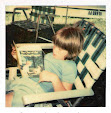Inquest (1933) by Henrietta Clandon (Vernon Loder)
In Clandon's debut mystery we find ourselves at a county house part at Hebble Chace. Hebble Chace is home to Marie Hoe-Luss who is now the widow of a wealthy English businessman. About six months ago, the Hoe-Lusses held a house-warming party at their French chateau. The unfortunate ending to that party was the death of William Hoe-Luss, apparently from the accidental ingestion of poisonous mushrooms. As Mr. Hoe-Luss had gathered the mushrooms himself, there was no real investigatio made by the French authorities for foul play--despite the fact that the man also had a broken neck from tumbling down stairs and whispers by certain members of the party that Marie Hoe-Luss made out rather well after her husband's death.
The house party at Hebble Chace is made up entirely of members of that house-warming party in France. Well, except for our narrator, Dr. Soames. Marie has added him to the mix at what seems to be an informal inquest after the fact. And--since Soames obviously wasn't directly involved in the events six months ago, everyone decides to confide in him their thoughts about the death of Hoe-Luss. One of the guests, is a devoted botanist and he tells Soames that none of the poisonous fungi mentioned in the doctor's report were to be found on the chateau grounds. Not long after sharing this information, Simcox, falls to his death from an upstairs window. Another apparent accident. But the clues don't add up and soon the Chief Constable has called in Inspector Mattock of the Yard to unravel the case.
Now...perhaps I should step back a moment and post a disclaimer before going with my review. With life as it is in the Hankins household, I am a bit sleep-deprived and it's possible I'm a little grumpier than usual about these things. So, please take my review with a grain of salt. But--please also let me say that the intro by Curtis Evans is wonderful and gives lots of interesting information about Clandon (aka Vernon Loder) and background information on this debut mystery for the Clandon name.
First, I want to get a couple of minor things off my chest. This isn't a long book--editions range from 193 to 209 pages yet it took me six days to read what would normally take one-two days. And it seemed much longer than that. I felt like I'd been reading it for about a month. Second, can anyone tell me what the yarn ball, knitting needles, and the hands making a rabbit shadow image have to do with anything, let alone the story inside??? It would make some sort of sense if we had a Miss Marple or Miss Silver character knitting away in the corner and playing detective. But nope. So, I have no clue. But befuddlement seems to be a running theme...
Color me baffled. I am at a loss to understand Dorothy L. Sayers' enthusiasm for this mystery. Sayers, who writes elegantly and with great care, doesn't seem to notice great swathes of dialogue that seem to make no sense. Sayers' Lord Peter piffles, it's true--but always with a point. And I never get lost in his speeches. Even when Sayers throws in Latin or French that I may not understand. The groundwork is so well-laid that I don't have to know the Latin or French to figure out what's going on. There are places in this novel where Dr. Soames (our narrator--more about him in a moment) has conversations with his fellow house guests that make little to no sense. I felt very much as I did when my husband had his most recent "brain event" last October. It's like two separate conversations are happening at once.
And..having mentioned Dr. Soames--for about half the novel he's about as swift as a dammed up river. He doesn't give us the best commentary on his fellow guests. He doesn't really question any of the medical details until facts are waved under his nose repeatedly. He thinks everything said is just "gossip" and mean-spirited gossip at that. When he finally wakes up to the fact that murder has been done, he then starts roaming among the suspects letting out little bits of information that maybe the police didn't want communicated. "Oopsie." [Not a direct quote. But my interpretation of his realization.] He waffles terribly between thinking each of the men have done the dirty deeds and that they haven't--and, of course, none of the women did. Two of the women, he only thinks about in relation to the men they're attached to...how awful for the little ladies if their betrothed is found to be a murderer.
Now, Inspector Mattock and Tobey, the Chief Constable, have more on the ball. Quite frankly, I think I would have enjoyed the mystery a lot more if we had followed Mattock about instead of Soames. Soames is meant to be our inside view into the country house party, but he just annoyed me for about half to two-thirds of the book. But--if we take out Soames and just follow the plot, it is fairly good. There is a nice bit of misdirection with a few of the clues and while the motive did strike me as a bit obvious (once I threw out the biggest red herring) the follow-up by Mattock on the trail was quite good.
My final quibble--and this is a bit of a SPOILER, even though I don't name the villain--
I don't like it (especially in older mysteries) when the culprit gets off completely. If the police manage to lock them up and send them forth for trial, then, by golly, I want the jury to do their duty and find the villain of the piece guilty. Yes, juries in real life can be iffy propositions and may let an obviously guilty person off for silly reasons. But don't do that in books, please. I'd like some justice in the world somewhere. And...the final quote (below) is an observation by the good doctor. Given how wrong he is about a great many things throughout the book, I wouldn't bet on our villain not trying their hand on more if the situation arose. ★★
First: During the last ten years of his life, I was medical adviser to Mr. Hoe-Luss.
It is amazing how suspicious people can become when their financial interests are threatened. (p. 17)
Last: But I am quite sure that [their*] two successful murders will not have inclined [them*] to try the charm of the third. [*pronouns changed to prevent spoilers.]
*****************
Deaths = two fell from height









.jpg)




















No comments:
Post a Comment